
The Australian Sharpie is a 3-person sailing dinghy which has evolved from the 12-square-metre class sailed in the 1956 Olympics in Melbourne, Australia. Australian Sharpies are 19 feet, 11+3⁄4 inches long, with a planing hull and a single mast. Sharpies race with a fully battened mainsail, a jib and a spinnaker.
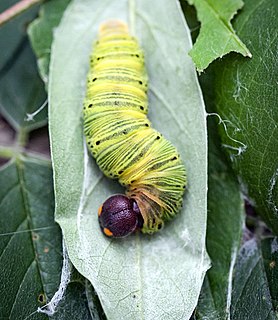
Epargyreus clarus, the silver-spotted skipper, is a butterfly of the family Hesperiidae. It is claimed to be the most recognized skipper in North America. E. clarus occurs in fields, gardens, and at forest edges and ranges from southern Canada throughout most of the United States to northern Mexico, but is absent in the Great Basin and western Texas.
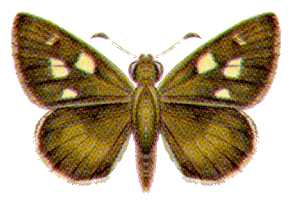
Hesperilla malindeva, the malindeva skipper or two-spotted sedge-skipper, is a butterfly of the family Hesperiidae. It is found in the Australian states of New South Wales and Queensland.
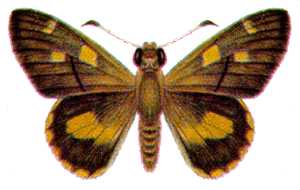
Hesperilla mastersi, the chequered sedge-skipper or Master's skipper, is a butterfly of the family Hesperiidae. It is found in the Australian states of New South Wales, Queensland and Victoria. It was also found in Tasmania, but the small area where its food plant was growing was cleared to provide cattle pasture. It is probably now extinct in Tasmania.

Hesperilla sexguttata, the riverine sedge-skipper or six-spot skipper, is a butterfly of the family Hesperiidae. It is found in Australia in the Northern Territory, Queensland and Western Australia.

Dispar compacta, the dispar skipper or barred skipper, is a butterfly of the family Hesperiidae. It is found in the Australian Capital Territory, New South Wales, Queensland, South Australia and Victoria.
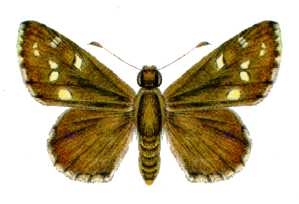
Proeidosa polysema, the polysema skipper or spinifex sand-skipper, is a butterfly of the family Hesperiidae. It is found in Australia in the Northern Territory, Queensland and Western Australia.
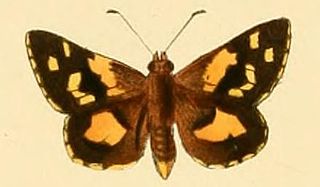
Croitana croites, the croites skipper or yellow sand skipper, is a butterfly of the family Hesperiidae. It is endemic to the western plateau and the north-west and south-west coast of the state of Western Australia.

Mesodina aeluropis, the aeluropis skipper or montane iris skipper, is a butterfly of the family Hesperiidae. It is endemic to New South Wales, Australia.
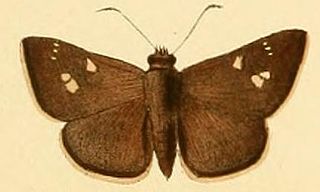
Mesodina halyzia, the eastern iris-skipper or halyzia skipper, is a butterfly of the family Hesperiidae. It is endemic to the Australian states of New South Wales, Queensland and Victoria.
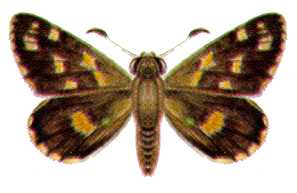
Oreisplanus munionga, the alpine sedge-skipper, is a butterfly of the family Hesperiidae. It is found in the Australian Capital Territory, New South Wales, Tasmania and Victoria.
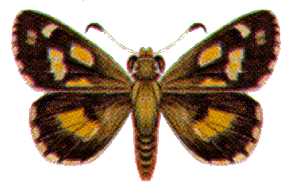
Oreisplanus perornata, the montane sedge-skipper or mountain spotted skipper, is a butterfly of the family Hesperiidae. It is found in the mountains of the Australian states of New South Wales and Victoria.
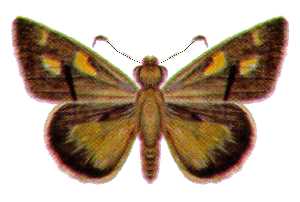
Toxidia andersoni, Anderson's skipper or the southern grass-skipper, is a butterfly of the family Hesperiidae. It is found in Australia in inland New South Wales, Queensland and Victoria.
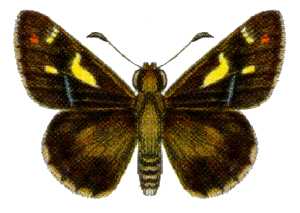
Toxidia doubledayi, the Doubleday's skipper or lilac grass-skipper, is a butterfly of the family Hesperiidae. It is found in the mountains and on the coastal plain of the east coast of Australia, including New South Wales and Queensland.

Toxidia rietmanni, the white-brand skipper or whitebranded grass-skipper, is a butterfly of the family Hesperiidae. It is found in the Australian states of New South Wales and Queensland.

Toxidia melania, the black skipper or dark grass-skipper, is a butterfly of the family Hesperiidae. It is endemic to the rainforests of tropical Queensland, Australia.

Toxidia parvulus, the parvula skipper or banded grass-skipper, is a butterfly of the family Hesperiidae. It is found in the Australian Capital Territory, New South Wales, Queensland and Victoria.
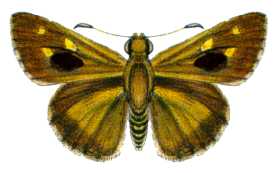
Signeta flammeata, the bright shield-skipper, is a butterfly of the family Hesperiidae. It is found in the Australian Capital Territory, New South Wales, Queensland, South Australia and Victoria.
Sisyphus Shelter is an archaeological site that was uncovered in Colorado when the Colorado Department of Highways was working on I-70. The excavation of this site became a joint project between the Colorado Department of Highways and the Bureau of Land Management. Fieldwork on the site was completed in 1980. Archaeologists John Gooding and Wm. Lane Shields as well as many others completed the excavation and prepared a comprehensive site report. Over the course of the fieldwork on Sisyphus Shelter, twenty-six features of human origin were discovered as well as numerous stone artifacts and two perishable items. The artifacts appeared to be all Late Archaic in origin. Dating indicated a range of occupations from modern times to 4400 B.P. being the oldest sample. Gooding and Shields (1985) suggest that the occupations of the shelter were not consistent and affected by seasonal changes.

Gretel II (KA-3) is an International 12-metre class racing yacht built for the America's Cup challenge series in 1970. She was designed by Alan Payne and built by W.H. Barnett for Australian media tycoon Sir Frank Packer.



















